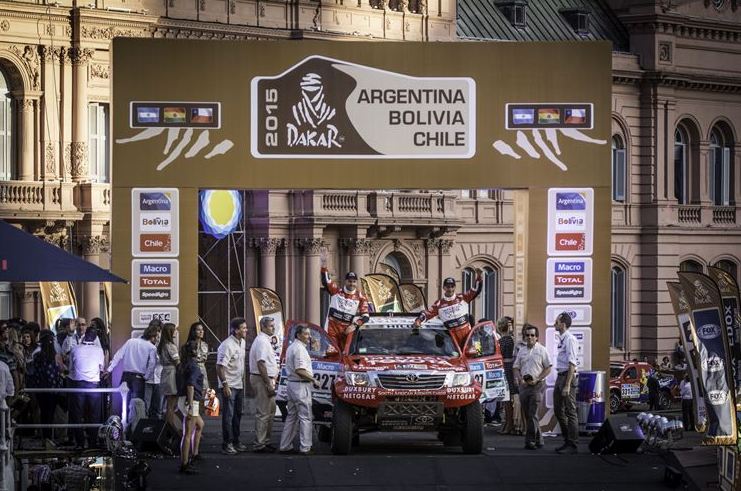BUENOS AIRES – With the start of Dakar 2015 now just hours away, the Toyota Imperial South African Dakar Team was pleased and somewhat relieved when all pre-race checks were completed successfully early on Saturday, 3 January. All that remained before the start of racing was the ceremonial start podium, which took place early in the evening of the same day.
“We are very pleased that every member of the team has successfully completed all the pre-race checks, which are quite significant,” said Team Principal Glyn Hall on Saturday. “More importantly, both our Toyota Imperial Hilux race vehicles have also passed through scrutineering without a hitch, essentially allowing us to take part in the race.”
The administrative checks and vehicle scrutineering on The Dakar are notoriously stringent, but in the world’s toughest motorsport event safety comes first, and as such it is necessary for the organisers to make sure that every person taking part in the event conforms to certain safety standards. This includes customs, medical and environmental declarations, equipment checks, briefings on the route and much more.
Clearing the checks can take a top team, such as the Toyota Imperial South African Dakar Team several days, as not only the two race vehicles but also each and every support vehicle and staff member needs to complete the checks. For the race crews – Giniel de Villiers and Dirk von Zitzewitz in the Toyota Imperial Hilux #303 and Leeroy Poulter and Rob Howie in #327 – the checks are even more intense, and also brings home the seriousness of this mammoth event.
With the checks completed it was time to take part in the ceremonial start of the race. This consisted of each crew driving their motorcycle, quad bike, truck or production race vehicle over a ramp and around a short parade route – with nearly a million Argentine fans looking on. It is one of the spectacles of the world’s toughest motor race, and it took several hours for the 414 competitors to complete the ceremony.
Dakar 2015 itself gets under way on Sunday January 4th, with a short liaison from the start in Buenos Aires, to the start of a 170 km long stage. This is followed by a long liaison of 519 km, which sees the crews overnight at the race’s first bivouac at the Argentine town of Villa Carlos Paz. Stage 1 consists of fast tracks with sharp bends, more akin to traditional rally stages than the spectacular open vistas of the Dakar.
“Our biggest competition is still sure to come from the MINIs,” said driver Giniel de Villiers before the start of the first day. “Nasser Al-Attiyah, Nani Roma and Orlando Terranova are all fast drivers, and we’ve seen how strong those cars are at high altitude. With that said, this is a new year and we have a new, more powerful and lighter Toyota Imperial Hilux – so let’s wait and see what happens on the first stage.”
For Leeroy Poulter, in the second Toyota Imperial Hilux, Dakar 2015 offers a chance to improve on his 33rd position at the end of the 2014 event. The Johannesburg-based driver has completed a full season in the Donaldson Cross-Country Championship back home, and is confident that the extra hours in the race vehicle, together with navigator Rob Howie, will make a massive difference.
“Not only that,” continued Poulter, “but we’ve also done a Dakar together now. So my entire mental state and outlook on the race is better now than last year. I have a much clearer picture of what to do, and can’t wait to get out there now.”
The team is fielding two brand new Toyota Hilux race vehicles, which feature a redesigned exterior, slightly larger air restrictor (37mm vs 36mm in 2014), new suspension setup, lower overall weight and many other significant changes. The vehicle was built in response to changes in the FIA’s regulations for the race, and may result in a more level playing field between the normally aspirated V8 petrol engines of the Toyota Imperial Hilux, and the turbo-charged diesel engines of the MINI team.
“The Dakar is not an easy event to win,” said Hall. “There are many, many people trying. But we are confident that our new race vehicle is better than ever, and this may just be our best shot yet.”
Toyota Motorsport South Africa Acknowledges Its Dakar Sponsors, Specialist Official Suppliers and Technical Partners:
Hallspeed, TFM, Castrol, SKF, Spanjaard, Robor, 4×4 Megaworld, NGK, Donaldson, Mastercraft, Sat4Rent, Oakley, Edgecam, Supreme Springs, FreeM, Bosch, Smiths Manufacturing and Shatterprufe. Also Duxbury Netgear, Innovation, Toyota Financial Services, SAA Cargo, Toyota and Imperial Toyota.
Difference between Cross-Country, Off-Road and Rally racing: The Dakar is a cross-country race where vehicles race between GPS waypoints as opposed to existing roads. In a rally (a la WRC) the cars race along closed roads. In an off-road race the competitors follow routes not suitable for cars, but they still have a set route to follow.
For the purpose of The Dakar, the event is called a rally (The Dakar Rally), though it doesn’t conform to the definition of a traditional rally. It has timed race (stages) and liaison (open road) sections where they do not race against the clock, but still have to depart at certain predetermined times and clock in before a given deadline to avoid time penalties.
In a rally, competitors race in similar fashion, but use multiple short stages (up to 25-35km each; around 5 or 6 special stages per day; 2-3 days per event).
In off-road racing an event consists of one long stage on a single day only, and an event is usually run over 2 days.
The Dakar lasts 14 days and covers 4,752 race kilometers and 9,295 km in total (combination of stages and liaisons). The event is split by a rest day at the halfway mark. It is officially the longest motorsport event in the world (distance and time).
